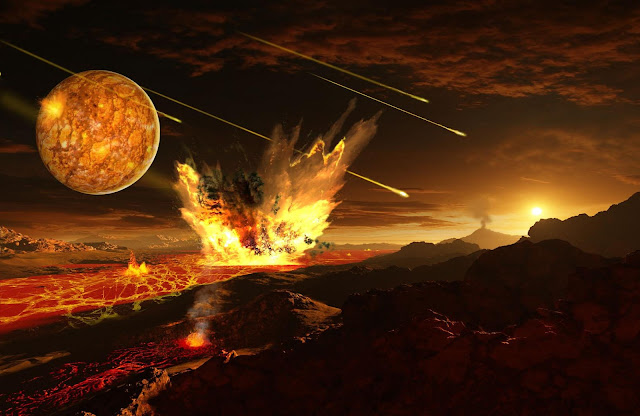The Late Heavy Bombardment (abbreviated LHB and also known as the lunar cataclysm) is an event thought to have occurred approximately 4.1 to 3.8 billion years (Ga) ago, corresponding to the Neohadean and Eoarchean eras on Earth. During this interval, a disproportionately large number of asteroids are theorized to have collided with the early terrestrial planets in the inner Solar System, including Mercury, Venus, Earth, and Mars. The LHB happened after the Earth and other rocky planets had formed and accreted most of their mass, but still quite early in Earth's history.
Evidence for the LHB derives from lunar samples brought back by the Apollo astronauts. Isotopic dating of Moon rocks implies that most impact melts occurred in a rather narrow interval of time. Several hypotheses are now offered to explain the apparent spike in the flux of impactors (i.e. asteroids and comets) in the inner Solar System, but no consensus yet exists. The Nice model is popular among planetary scientists; it postulates that the giant planets underwent orbital migration and scattered objects in the asteroid and/or Kuiper belts into eccentric orbits, and thereby into the path of the terrestrial planets. Other researchers argue that the lunar sample data do not require a cataclysmic cratering event near 3.9 Ga, and that the apparent clustering of impact melt ages near this time is an artifact of sampling materials retrieved from a single large impact basin. They also note that the rate of impact cratering could be significantly different between the outer and inner zones of the Solar System.
The main piece of evidence for a lunar cataclysm comes from the radiometric ages of impact melt rocks that were collected during the Apollo missions. The majority of these impact melts are believed to have formed during the collision of asteroids or comets tens of kilometers across, forming impact craters hundreds of kilometers in diameter. The Apollo 15, 16, and 17 landing sites were chosen as a result of their proximity to the Imbrium, Nectaris, and Serenitatis basins respectively.
Under study on Earth, the ages of impact melts collected at these sites clustered between about 3.8 and 4.1 Ga. The apparent clustering of ages of these was first noticed in the mid-1970s led to postulation that the ages record an intense bombardment of the Moon. They called it the "lunar cataclysm" and proposed that it represented a dramatic increase in the rate of bombardment of the Moon around 3.9 Ga. If these impact melts were derived from these three basins, then not only did these three prominent impact basins form within a short interval of time, but so did many others based on stratigraphic grounds. At the time, the conclusion was considered controversial.
As more data has become available, particularly from lunar meteorites, this theory, while still controversial, has gained in popularity. The lunar meteorites are believed to randomly sample the lunar surface, and at least some of these should have originated from regions far from the Apollo landing sites. Many of the feldspathic lunar meteorites probably originated from the lunar far side, and impact melts within these have recently been dated. Consistent with the cataclysm hypothesis, none of their ages was found to be older than about 3.9 Ga. Nevertheless, the ages do not "cluster" at this date, but span between 2.5 and 3.9 Ga.
Dating of howardite, eucrite and diogenite (HED) meteorites and H chondrite meteorites originating from the asteroid belt reveal numerous ages from 3.4–4.1 Ga and an earlier peak at 4.5 Ga. The 3.4–4.1 Ga ages has been interpreted as representing an increase in impact velocities as computer simulations using hydrocode reveal that the volume of impact melt increases 100–1000 times as the impact velocity increases from the current asteroid belt average of 5 km/s to 10 km/s. Impact velocities above 10 km/s require very high inclinations or the large eccentricities of asteroids on planet crossing orbits. Such objects are rare in the current asteroid belt but the population would be significantly increased by the sweeping of resonances due to giant planet migration.
Studies of the highland crater size distributions suggest that the same family of projectiles struck Mercury and the Moon during the Late Heavy Bombardment. If the history of decay of late heavy bombardment on Mercury also followed the history of late heavy bombardment on the Moon, the youngest large basin discovered, Caloris, is comparable in age to the youngest large lunar basins, Orientale and Imbrium, and all of the plains units are older than 3 billion years.
Explanation from: https://en.wikipedia.org/wiki/Late_Heavy_Bombardment


 About
About Tags
Tags Popular
Popular









0 komentar:
Posting Komentar